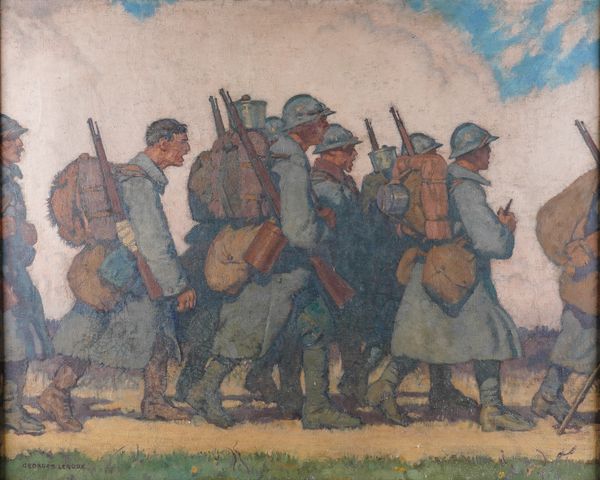GEORGES PAUL LEROUX (FRENCH, 1877-1957)
Soldiers
signed 'GeORGeS LeROUX' (lower left)
oil on canvas
81 x 105cm
ARR
Provenance
Purchased in a brocante in Saint-Valery-sur-Somme, France, circa 2005 by the current owner
| Estimate: | £5,000 - £8,000 |
| Hammer price: | £6,500 |
Footnote
Born in Paris in 1877, to parents with strong connections to Trelly in Normandy, Georges Paul Leroux undertook his formal art training first at the Ecoles des Arts Decoratifs and then under Leon Joseph Bonnat (1883-1922) at the Ecoles des Beaux-Arts in Paris. A frequent exhibitor at the Salon des Artistes Francaise, he was awarded the 3rd Class Medal in 1903 and, in 1906, the Prix de Rome, which enabled him to stay at the Villa Medici in Italy from 1907-1909. In 1908 Leroux was awarded the Chevalier de la Legion d'Honneur. In 1911 he won a 2nd Class Medal and in 1932 was elected as a member of the L'Institut de France.
Today, Leroux's works can be found in private collections as well as major galleries and museums, including the Imperial War Museum, the Petit Palais in Paris, and the Musee Departemental de l'Oise in Beauvais.
During the First World War, Leroux served in the French army and saw action on the Western Front, in France and Belgium. These experiences lead him to paint various pictures of soldiers and war. It is understood, for example, that when out on a reconnaissance mission he saw 'a group of French soldiers taking shelter in a great shell hole full of water', and later that evening started making sketches of what he had seen, which later lead to perhaps his most famous work, L'Enfer (Hell), completed in 1921 and now in the collection of The Imperial War Museum (Art.IWM ART 4415).
In the present work, of French soldiers marching, one might assume it was painted during a similar period to L'Enfer, in those years that followed the end of the First World War after 1918, drawing on Leroux's earlier experiences. Clearly French, due to the blue uniforms they wear, it appears as though they are near, or have been near The Front, as one soldier to the left wears a pair of brown German boots, presumably acquired from a German soldier on the battlefield, as opposed to his own. Leroux presents us with an engaging composition, not dissimilar to the one used in Gassed by John Singer Sargent, as a line of men cross the canvas from left to right. Leroux places the viewer close to the men, as if they were stood on the edge of the path watching them go by, with only half a man visible to the extreme left and right sides, out of the viewers field of vision, as they march past. This provides us with a study of a small group of soldiers whilst also reminding us of the almost continuous procession of men sent to war, bringing to mind works by C. R. W. Nevinson.
In some ways it is a painting of juxtapositions, the soldiers are marching through a beautiful landscape, with glimpses of ploughed fields and woodland, set against a huge sky full of billowing clouds with pockets of blue above, in stark contrast to the atrocities of war. However, these same clouds, so dominant in the picture, also remind the viewer of the smoke from exploding shells and the oppressive nature of it, the ploughed brown fields are perhaps reminiscent of the mud enveloped, desolate landscape found at The Front.
None of the men are wounded and they do not appear particularly dirty as if they have spent weeks in the trenches. They are clearly singing, all with their mouths open; one holds a pipe, as another one, with a bandaged rifle and the German boots, strains forward, determined to keep going. One wonders where they are going, out to, or coming home from, The Front? Perhaps this is deliberately ambiguous? Taken as a whole, Soldiers is a stunning and rare work, evocative of the period and layered with meaning.


